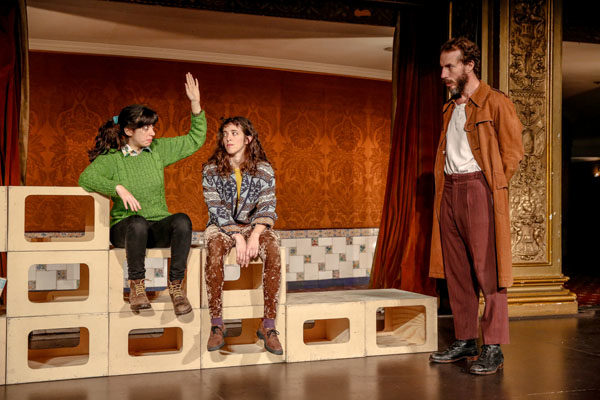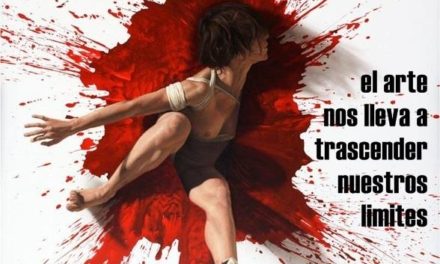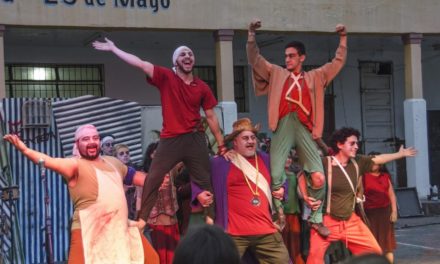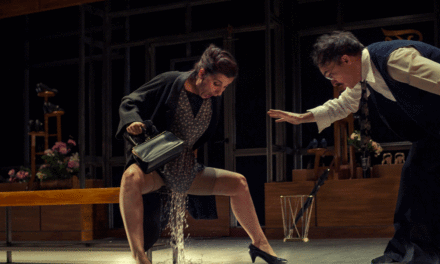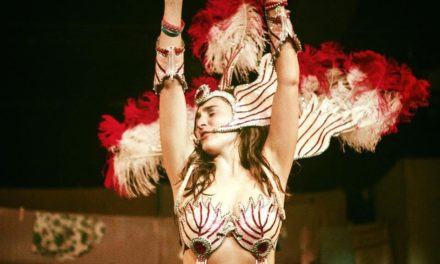“A work of art is good if it has arisen out of necessity. That is the only way one can judge it,” declares Rainer Maria Rilke in “Letter number one” from his Letters to a Young Poet.
Just as in her excellent previous trilogy, developed with her company El Silencio — namely Algo de ruido hace (2007), El tiempo todo entero (2010) and Fauna (2013) — playwright and director Romina Paula’s Cimarrón (Wild Animal) has clearly emerged from a strong need to unfold a singular and personal language onstage. It’s a language that consists of important doses of storytelling (Paula is also a brilliant novelist), but which also has strong connection to music (as in real music, but also the subtle music of the performers’ movements), the visual arts, poetry and — in this latest play, which was presented last year at the Teatro Argentino de La Plata and now can be seen at the Teatro Cervantes — a playful approach to dance.
There are dozens of theatrical productions which intersperse different intertextual materials. And those productions, in some cases, may turn out to be tedious or works of snobbery. Whether the sources and texts are unveiled or explained, or not, there is always a superior voice addressing the viewers in a pedagogic or — on the contrary — ciphered manner, eventually leaving them alien to the artistic event.
Yet Paula’s works, especially Cimarrón, currently at Teatro Cervantes, run totally opposite to this perspective, because she authentically delivers her impressions and leaves behind sensations through certain readings and encounters with varied artistic expressions.
She is capable of twinning Lucha Reyes and Chabuca Granda’s moving songs — danced to by the actresses in different contemporary styles — with Rilke’s profound and very modern thoughts about art, love, and women and with Sarah Ruhl’s play Late: a cowboy song, with quantum physics, all of them fluidly and naturally, as if they were all part of the same universe. And they are because they are part of her own constellation of references and creative triggers shared with the audience in a sensitive, sincere way.
Besides that, Paula generates her own fictions by blending and intermingling those materials very freely and adding some more, such as with Luciano Lamberti’s short story “La canción que cantábamos todos los días” (“The Song We Used to Sing Everyday”), Theodor Storm’s short novel The Rider on a White Horse, Werner Herzog’s movie The Enigma of Kaspar Hauser, the motives of Romantic painter Caspar David Friedrich’s works (the program itself quotes his Moon Rising Over the Sea) and the attractive and overwhelming idea or experience of the sublime, represented in some of his landscapes, and which gathers through the feeling of amazement of the horrible and the delightful.
Storytellers
Agostina Luz López, Denise Groesman, and Esteban Bigliardi are the storytellers, the dancers and performers of poetic scenes which are always closer to the narration or the manifestation of ideas than traditional acting. Groesman has even participated as a painter in the show, since she is the author of the canvas which can be seen on one side of the stage during the play, named Los perros lamen las llagas de los heridos (The Dogs Lick the Sores of the Wounded).
On an almost empty stage, which highlights the traditional architecture of the Luisa Vehil Auditorium and the fact that we are at the theatre, in a space which can be filled with any story, all three are like changeable presences. These “entities” lend their bodies and their voices, portraying fleeting characters, though the three performers — who are very expressive and moving in their peaceful and delicate ways of working onstage — retain consistent lines throughout the play: the architect and the rider from Storm’s aforementioned story, Rilke himself, the “boy/girl” from Ruhl’s play, the sister of a possessed boy, a girl who talks about the relationship with her father and about black holes in Switzerland, among others.
Directed by Paula’s accurate hand, they smoothly lead and captivate the viewer through different thoughts, states, and stories.
Metamorphosis
A feeling of constant metamorphosis can be perceived while watching Cimarrón. Indeed, the title alludes to a domestic animal which has run away from its owners and turns wild. The aforementioned painting, seen throughout the performance, is explicit in this sense because it shows in the foreground an image — similar to those produced by Henri Rousseau — of a dog licking a woman, as if it were a wolf, in a natural landscape.
This dog who has turned into a wild creature sparks recollections of Red, the “cowboy girl” from Ruhl’s play, who has also become a wild person, living alone on the outskirts of the city, where she tames colts and rides horses. A character that, in certain features, is similar to the one evoked in Paula’s previous play, Fauna. And there is another profound transformation in Kaspar Hauser and in the boy who has been possessed in the story by Lamberti.
This metamorphosis is also connected with the transformations from one character to another, and from one material to another from a totally different source, together with the transformations made by Paula herself on each of those materials.
Fabián Casas explains this in the program: “The cimarrón is an animal which becomes wild. Romina Paula is a director who turns into an animal and who seems to have the need of taking her ‘audience’ out of their comfortable seats. People have the feeling that the play is a mystery for her.”
In the play, this is also expressed when, through Rilke, the male character underlines the ineffable nature of the work of art. Paula herself has declared that “the play, the stage moment, happens ‘in-between’: in the connection between those readings, between the players and those words, between those words and the music, between the bodies and space. A man who inhabits the time of German Romanticism, two women of this hemisphere, at the present time, get together and create stories. They exist while saying; they talk to exist.”
Succession
And while they talk, they thread an original succession of thoughts, images, and events which are not at all linear, but rather rhizomatic.
There is no conventional story, neither are the scenes narratively connected in a traditional structure. But there is always some aspect or detail of one of the material that leads — maybe through an oblique trajectory — to the other, a scene which brings about the following in an unexpected, surprising way, stimulating the audience’s intuition and imagination to find in themselves their own stories and reflections.
Cimarrón is a wonderful example of free association onstage, a generous and honest delivery of interpretations and connections of different artistic expressions.
“Can people still say ‘love, art, poetry’ and not make a fool of themselves?” is one of the emblematic lines of Cimarrón.
Paula, López, Groesman, and Bigliardi show, with their work, that it is possible to go on dealing with those concepts by being authentic and creating or expressing themselves diving in their own needs. Following on from Rilke: “rescuing themselves from these general themes and writing about what their everyday life offers them; describing the thoughts that pass through their mind and their belief in some kind of beauty; describing all these with heartfelt, silent, humble sincerity.”
When and where
Cimarrón, Fridays to Sundays, 6 pm at the Teatro Cervantes
This article was originally published on Buenos Aires Herald. Reposted with permission. Read the original article.
This post was written by the author in their personal capacity.The opinions expressed in this article are the author’s own and do not reflect the view of The Theatre Times, their staff or collaborators.
This post was written by Victoria Eandi.
The views expressed here belong to the author and do not necessarily reflect our views and opinions.

